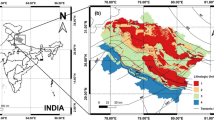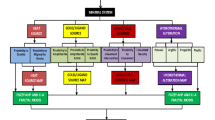Abstract
Coal mine fire is a serious problem in Jharia coal field, India. The coal mine fire can be detected with different techniques such as borehole temperature measurement, thermo-compositional analysis, remote sensing techniques, thermo-graphic measurement and geophysical methods. In this study, various geophysical methods were used to detect the surface and subsurface coal mine fires. Geophysical techniques used in the present study are apparent resistivity, self-potential (SP), magnetic method and thermography. Geophysical anomalies such as low SP value of \(-60\hbox { mV}\), high negative magnetic response and low apparent resistivity value helped us to detect and delineate the fire and non-fire areas laterally as well as depthwise. Furthermore, the thermography survey was carried out in the coal field using thermal imaging camera in order to substantiate the geophysical methods. This integrated approach was found to be more advantageous for the detection and delineation of surface and subsurface fire with respect to use of any specific techniques. Moreover, the level of threat towards the locality, national railway line was also assessed unambiguously using the above techniques. Hence, proper planning and implementation towards the mitigation of hazard can be achieved on the basis of the reported results.





Similar content being viewed by others
References
Bartel L C 1982 Evaluation of the CSAMT geophysics technique to map abandoned coal mine fires: Department of energy contract DE-AC04-76DP00789, Sandia National Labs; Presented at the 52nd annual international SEG meeting, Dallas.
Bharti A K, Pal S K, Priyam P, Kumar S, Srivastava S and Yadav P K 2016 Subsurface cavity detection over Patherdih colliery, Jharia Coalfield, India using electrical resistivity tomography; Environ. Earth Sci. 75(5) 1–17.
Chatterjee R S 2006 Coal fire mapping from satellite thermal IR data – A case example in Jharia coalfield, Jharkhand, India; ISPRS J. Photogr. Rem. Sens. 60(2) 113–128.
Chatterjee R S, Wahiduzzaman M, Ankit S, Raju E V R, Lakhera R C and Dadhwal V K 2007 Dynamics of coal fire in Jharia coalfield, Jharkhand, India during the 1990s as observed from space; Curr. Sci. 92(1) 61–68.
Corwin R F and Hoover D B 1979 The self-potential method in geothermal exploration; Geophysics 44 226–245.
Dai S, Ren D, Tang Y, Shao L Y and Li S S 2002 Distribution isotopic variation and origin of sulfur in coals in the Wuda coalfield, Inner Mongolia, China; Int. J. Coal Geol. 51(4) 273–250.
Gangopadhyay P K 2003 Coalfire detection and monitoring in Wuda North China – A multi-spectral and multi-sensor TIR approach; MSc (Geo-information) Thesis, Int. Inst. Geo-infor. Sci. Earth Observation Enschede, Netherlands, 19p.
Hatherly P 2013 Overview on the application of geophysics in coal mining; Int. J. Coal Geol. 114 74–84.
Ide T S, Crook N and Orr F M Jr 2011 Magnetometer measurement to characterize a subsurface coal fire; Int. J. Coal Geol. 87 190–196.
Karaoulis M, Revil A and Mao D 2014 Localization of coal seam fire using combined self-potential and resistivity data; Int. J. Coal Geol. 129 109–118.
King A 1987 Cindered coal detection using transient electromagnetic methods; Geoexploration 24 367–379.
Kuenzer C and Stracher G B 2012 Geomorphology of coal seam fires; Geomorphology 138(1) 209–222.
Kuenzer C, Hecker C, Zhang J, Wessling S and Wagner W 2008 The potential of multidiurnal MODIS thermal bands data for coal fire detection; Int. J. Rem. Sens. 29(3) 923–944.
Mishra R K, Bahuguna P P and Singh V K 2011 Detection of coal mine fire in Jharia coal field using Landsat-7 ETM+ data; Int. J. Coal Geol. 86 73–78.
Mishra R K, Pandey J, Chaudhary S K, Khalkho A and Singh V K 2012 Estimation of air pollution concentration over Jharia coalfield based on satellite imagery of atmospheric aerosol; Int. J. Geoma. Geosci. 2(3) 723–729.
Mishra R K, Roy P N S, Pandey J, Khalkho A and Singh V K 2014 Study of coal fire dynamics of Jharia coal field using satellite data; Int. J. Geoma. Geosci. 4(3) 477–484.
Pal S K, Vaish J, Kumar S and Bharti A K 2016 Coal fire mapping of East Basuria colliery, Jharia coalfield using vertical derivatives technique of magnetic data; J. Earth Syst. Sci. 125(1) 165–178.
Pandey J, Kumar D, Mishra R K, Mohalik N K, Khalkho A and Singh V K 2013 Application of thermography technique for assessment and monitoring of coal mine fire: A special reference to Jharia coalfield, Jharkhand, India; Int. J. Adv. Rem. Sens. GIS 2(1) 138–147.
Pandey J, Kumar D, Singh V K and Mohalik N K 2016 Environment and socio-economic impacts of fire in Jharia coalfield, Jharkhand, India: An appraisal; Curr. Sci. 110(9) 1639–1650.
Prakash A and Gupta R P 1999 Surface fire in Jharia coalfield, India – Their distribution and estimation of area and temperature from TM data; Int. J. Rem. Sens. 20(10) 1935–1946.
Prakash A, Gupta R P and Saraf A K 1997 A Landsat TM based comparative study of surface and subsurface fire in the Jharia coalfield, India; Int. J. Rem. Sens. 18(11) 2463–2469.
Revil A, Karaoulis M, Srivastava S and Byrdina S 2013 Thermoelectric self-potential and resistivity data localize the burning front of underground coal fires; Geophysics 78(3) 259–273.
Rodriguez B D 1983 A self-potential investigation of a coal mine fire; MS Thesis, Colorado School of Mines, 132p.
Schaumann G, Siemon B and Changchun Y 2005 Geophysical Investigation of Wuda coal mining area, Inner Mongolia, electromagnetic and magnetic for coal fire detection; In: International conference on spontaneous coal seam fires: Mitigating a global disaster, ERSEC Ecological Book Series – 4, Beijing, PR China, pp. 336–350.
Shao Z, Wang D, Wang Y and Zhong X 2014 Theory and application of magnetic and self potential method in the detection of Heshituluogai coal fire, China; J. Appl. Geophys. 104 64–74.
Singh K K K, Singh K B, Lokhande R D and Prakash A 2004 Multielectrode resistivity imaging technique for the study of coal seam; J. Sci. Ind. Res. 63 927–930.
Sinha A and Singh V K 2005 Spontaneous coal seam fires: A global phenomenon; In: International conference on spontaneous coal seam fires: Mitigating a global disaster, ERSEC Ecological Book Series – 4, Beijing, PR China, pp. 42–65.
Sternberg R and Lippincott C 2004 Magnetic surveys over clinkers and coal seam fires in Western North Dakota; In: Denver annual meeting of the Geological Society of America 15(9).
Vaish J and Pal S K 2015 Subsurface coal fire mapping using magnetic survey at East Basuria colliery, Jharkhand; J. Geol. Soci. India 86(4) 438–444.
Xin M, Zhu H, Xiang M, Zhang Y and Liu D 2015 Application of transient electromagnetic method in coal mine fire detection; Metallurg. Min. Indus. 6 321–326.
Zhang J, Zhongdan H, Mei, Wang and Yaling X 2005 3D Detection and visualization of underground coal fires; In: International conference on spontaneous coal seam fires: Mitigating a global disaster, ERSEC Ecological Book Series – 4, Beijing, PR China, pp. 410–425.
Acknowledgements
Authors acknowledge Suman Konar, Jayanta Ghosh and Sukdev Das, MSc (Tech) undergraduate ISM students for the necessary help. The authors are grateful to the Director IIT (ISM), Dhanbad and the CSIR-Central Institute of Mining and Fuel Research Barwa Road, Dhanbad for their kind support in conducting the study. Authors would like to acknowledge anonymous reviewers and the Editor for reviewing the paper for substantial improvement.
Author information
Authors and Affiliations
Corresponding author
Additional information
Corresponding editor: N V Chalapathi Rao
Rights and permissions
About this article
Cite this article
Mishra, R.K., Roy, P.N.S., Singh, V.K. et al. Detection and delineation of coal mine fire in Jharia coal field, India using geophysical approach: A case study. J Earth Syst Sci 127, 107 (2018). https://doi.org/10.1007/s12040-018-1010-8
Received:
Revised:
Accepted:
Published:
DOI: https://doi.org/10.1007/s12040-018-1010-8




